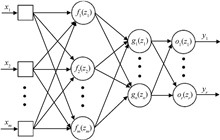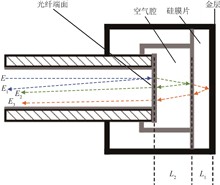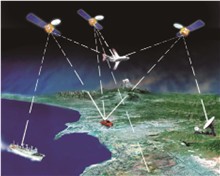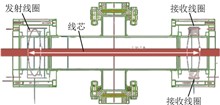In response to the need for rapid and highly sensitive detection of tuberculosis antigens and novel coronavirus proteins, a highly⁃sensitivity optical microfiber sensor for detecting tuberculosis antigens (MPT64 protein, Ag85B protein) and the nucleocapsid (N) protein of severe acute respiratory syndrome coronavirus 2 (SARS⁃CoV⁃2) has been developed. The optical microfiber sensor is coated with graphene oxide (GO) which offers extremely high surface area and excellent optical properties, and can significantly enhance the conical optical fiber's immobilization capacity; the GO⁃coated conical optical fiber is further functionalized with single⁃stranded DNA (ssDNA) aptamers, enabling efficient capture of target proteins and facilitating real⁃time detection in vitro. The prepared sensor is employed to detect the target analytes. The experimental results reveal that the sensor can rapidly detect MPT64 and Ag85B in complex samples within 10 s, achieving detection limits of 4.23 × 10⁻²⁰ M and 3.11 × 10⁻¹⁹ M, respectively. Additionally, the sensor exhibits a detection limit of 6.25 × 10⁻¹⁹ M for the N protein of SARS⁃CoV⁃2. The optical microfiber sensor possesses the advantages of high sensitivity and rapid detection, and is expected to play an important role in medical fields such as tuberculosis diagnosis and coronavirus detection.
To improve the identification accuracy of the static model of quartz flexible accelerometer, this study proposes a static model parameter identification method based on a Particle Swarm Optimization⁃Back Propagation (PSO⁃BP) neural network. This approach addresses the local optima susceptibility of Back Propagation (BP) neural networks through Particle Swarm Optimization (PSO) integration. The neural architecture is configured according to accelerometer input⁃output dimensions, where the PSO's global exploration capability optimizes the initial weight for the BP network. Precision centrifuge⁃based calibration experiments were conducted to validate the proposed method. Experimental results demonstrate that the PSO⁃BP neural network exhibits significantly enhanced capability in resolving nonlinear coefficients compared to the standard BP network, achieving a reduction of the mean squared error (MSE) by two orders of magnitude, which provides technical support for advancing the development of high⁃precision navigation technologies in airborne inertial navigation systems.
To enhance the demodulation accuracy of vernier spectral signals in Fabry⁃Pérot (F⁃P) sensors, this study proposes a direct deep learning⁃based demodulation method for spectral data. The method involves preprocessing spectral data to convert complex vernier spectral information into formats compatible with Convolutional Neural Network (CNN), followed by training and testing deep learning models on the processed full⁃spectrum data. The CNN architecture was employed for feature extraction and classification of spectral data, enabling accurate demodulation of target signals. Experimental validation was conducted utilizing spectral data collected from a dual⁃cavity F⁃P sensor with 112.5 nm / MPa sensitivity. The results demonstrate that the CNN model achieved an average accuracy of 92.49% with 10⁃fold cross⁃validation, accompanied by a Root Mean Square Error (RMSE) of 0.039 2 MPa and a mean relative error of 3.31%. The hybrid Convolutional Neural Network⁃Long Short Term Memory (CNN⁃LSTM) model exhibited superior performance with an average accuracy of 96.98%, an RMSE of 0.039 0 MPa, and a mean relative error of 3.28%. Notably, the CNN⁃LSTM approach attained high precision using only 256 sampled data points, demonstrating remarkable efficiency. This method provides an effective technical pathway for advancing spectral signal demodulation technology, offering significant reference value for developing intelligent optical sensing systems.
The key technologies of low⁃altitude aircraft navigation are introduced, encompassing fundamental navigation techniques and comprehensive augmentation methodologies. A thorough analysis is conducted regarding the present state of navigation system testing technologies, with particular emphasis on the categorization and evaluation of various testing methodologies for critical navigation parameters. These include position⁃velocity measurement, heading determination, attitude assessment, and verification approaches for integrated enhancement technologies. It is pointed out that the test technology faces the deficiency in verification capabilities in two aspects: adaptability to complex scenarios and anti⁃interference ability, the lag between standardization and supervision, and the contradiction between test cost and scale, and it presents the trends of intelligence, standardization and globalization, scenario diversification, low⁃carbon and sustainability, which provides a reference for the further development of low⁃altitude aircraft navigation system test technology.
To solve the problems of low precision and poor reliability of traditional contact sensors in the detection of high?voltage cable suspension, a non?contact displacement detection system of high?voltage cable suspension differential mutual inductance is developed by applying the principle of electromagnetic induction and adopting the differential mutual inductance measurement technology through the coordinated work of the transmitting circuit and receiving circuit, which realizes the high?precision detection of the position of the cable core. The transmitting circuit drives the transmitting coil by enhancing the 85 kHz sinusoidal signal, and the receiving circuit converts the received signal into ± 5 V direct voltage signal and 4 ~ 20 mA current signal. To effectively suppress the radiated interference, which is mainly concentrated in the receiving coil and its transmission path, a combination of shielded transmission line and band?pass filter is used to minimize the noise effect. The experimental results show that the best performance of sensor linearity and sensitivity is achieved in the displacement range of ± 30 mm, with linearity up to 97.49% and sensitivity up to 35.93 mV / mm. This system significantly improves the detection accuracy of high?voltage cables, overcomes the limitations of the traditional detection methods, and demonstrates good stability and reliability.
Cavity optomechanical sensors, as a focal point at the intersection of technology and science, are pivotal for improving sensing resolution across diverse applications. This research modulates the intracavity optical field mode volume by adjusting the optical fiber coupling state to achieve controllable optomechanical coupling, leading to a strong coupling lock state. Within a chip⁃scale optomechanical sensor resonator system constructed from two⁃dimensional photonic crystals, the study successfully demonstrated the enhancement of mechanical quality factor (Q⁃factor) and the suppression of system noise through controllable optomechanical coupling. Experimental results indicate that in the strong optomechanical coupling lock state, the mechanical Q⁃factor is increased by approximately 10 times compared to the weak coupling state, and system noise is significantly reduced by about 26 dB. Moreover, the optomechanical accelerometer sensor, based on this scheme, achieves a sensitivity of 126.58 mV / g under a 6 kHz acceleration drive. This study not only validates the potential of controllable optomechanical coupling in enhancing mechanical Q⁃factor and reducing system noise, but also offers new perspectives for the design and application of optomechanical systems, significantly advancing the development in photonic and micro⁃nano mechanical systems.












